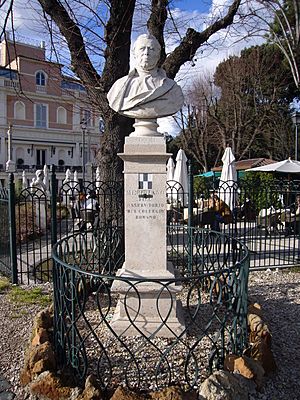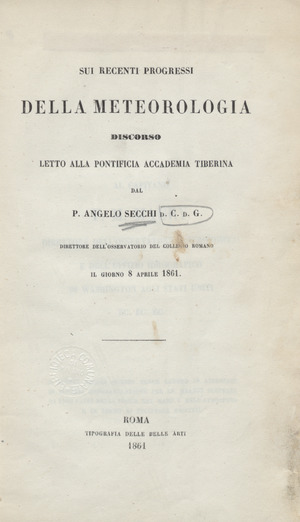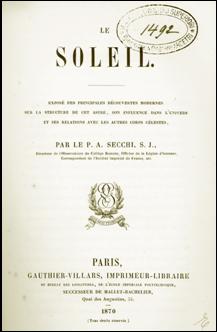Angelo Secchi facts for kids
Quick facts for kids The Reverend Father Angelo Secchi S.J. |
|
|---|---|
 |
|
| Church | Latin Church |
| Orders | |
| Ordination | 12 September 1847 |
| Rank | Priest |
| Personal details | |
| Born | 28 June 1818 Reggio Emilia, Duchy of Modena and Reggio |
| Died | 26 February 1878 (aged 59) Rome, Kingdom of Italy |
| Nationality | Italian |
| Denomination | Catholicism |
Angelo Secchi was an Italian Catholic priest and astronomer. He was a member of the Jesuit Order. For 28 years, he was in charge of the observatory at the Pontifical Gregorian University in Rome. He was a pioneer in studying light from stars, a field called astronomical spectroscopy. He was also one of the first scientists to clearly state that the Sun is actually a star.
Contents
About Angelo Secchi
Angelo Secchi was born on June 28, 1818, in Reggio Emilia, Italy. When he was 16, he joined the Jesuit Order in Rome. The Jesuits are a religious group within the Catholic Church.
Early Life and Studies
Secchi studied at the Jesuit school in his hometown. He then continued his studies at the Roman College, where he showed a great talent for science. In 1839, he became a teacher of mathematics and physics at the college. Later, in 1841, he became a physics professor at another Jesuit College in Loreto.
In 1844, he began studying theology (the study of religious faith). He became a priest on September 12, 1847.
Time Abroad
In 1848, the Jesuits had to leave Rome because of political changes. Angelo Secchi spent the next two years in England at Stonyhurst College. There, he met another Jesuit astronomer, Alfred Weld. Weld was in charge of the Stonyhurst Observatory, and he might have inspired Secchi to focus on astronomy.
After England, Secchi moved to the United States. He taught for a while at Georgetown University in Washington, D.C. While there, he also finished his advanced studies in theology. During his time in America, he met Commander Matthew Fontaine Maury. Maury was the first director of the United States Naval Observatory. Secchi studied with Maury and they stayed in touch for many years.
Return to Rome and the Observatory
Secchi returned to Rome in 1850. He was recommended by a colleague to become the head of the observatory at the Roman College. He was only 32 years old.
In 1853, under his leadership, the old observatory was moved to a new building. It was placed on top of the Sant'Ignazio Church. Secchi remained the director of this observatory until he passed away.
Challenges and Dedication
After 1870, Rome became part of the Kingdom of Italy. The Italian government tried to take over the Roman College and its observatory. Secchi strongly disagreed with this. He even threatened to leave Rome for other observatories that offered him jobs.
The government offered him important scientific positions and honors. However, he refused to promise loyalty to the King instead of the Pope. Because of his strong stand, the government did not interfere with him. He continued to be the director of the observatory.
Angelo Secchi died in Rome in 1878, at the age of 59.
Amazing Discoveries in Astronomy
Secchi made many important contributions to different areas of astronomy.
- He updated a catalog of double stars. These are two stars that appear close together in the sky. He collected information for over 10,000 pairs of stars.
- He discovered three comets, including one named Comet Secchi.
- He created a very detailed map of the lunar crater Copernicus on the Moon.
- He drew some of the first color pictures of Mars. He was also the first to describe "channels" (called canali in Italian) on the surface of Mars.
Studying the Sun
Secchi was especially interested in the Sun. He watched it constantly throughout his career.
- He observed and drew solar eruptions and sunspots. Sunspots are darker, cooler areas on the Sun's surface. He kept detailed records of how active the sunspots were.
- In 1860 and 1870, he organized trips to observe solar eclipses.
- He proved that the solar corona (the Sun's outer atmosphere) and bright solar prominences (loops of gas) seen during an eclipse are actually part of the Sun. They are not just optical illusions caused by the eclipse.
- He discovered solar spicules, which are thin jets of gas shooting up from the Sun's surface.
Pioneer of Stellar Spectroscopy
Secchi's main area of interest was astronomical spectroscopy. This is the study of light from stars to learn what they are made of.
- He invented special tools like the heliospectrograph and star spectrograph. These tools help break starlight into its different colors.
- He showed that certain dark lines in the spectrum (rainbow of colors) of the Sun are caused by gases in Earth's atmosphere absorbing some of the light.
Starting in 1863, he began collecting the spectra of stars. He gathered about 4,000 stellar spectrograms (pictures of star spectra). By studying this data, he found that stars could be grouped into a few main types. These types could be told apart by their different light patterns.
From this idea, he created the first system for stellar classification. This system had five Secchi classes of stars. Even though his system was later replaced by the Harvard system, he is still known as the person who discovered the idea of classifying stars. This is a very important part of astrophysics (the study of stars and the universe). He also recognized molecular bands of carbon in the spectra of some stars. This made him the discoverer of carbon stars, which formed one of his spectral classes.
Other Scientific Work
Secchi was also active in other science fields. These included oceanography (study of oceans), meteorology (study of weather), and physics.
- He invented the Secchi disk. This simple tool is still used today to measure how clear water is in oceans, lakes, and fish farms.
- He studied the climate of Rome. He also invented a "Meteorograph" to easily record different types of weather data.
- He studied the aurora borealis (Northern Lights), the effects of lightning, and what causes hail.
- He set up a system to regularly monitor Earth's magnetic field. In 1858, he opened a magnetic observatory in Rome.
Secchi also did technical work for the government of the Papal States.
- He helped place sundials and oversaw the repair or installation of city water systems.
- From 1854 to 1855, he supervised a very accurate survey of the Appian Way in Rome. This survey was later used to map Italy.
- He supervised the building of lighthouses for the ports of the Papal States. In 1858, he traveled to France and Germany to get the special lenses needed for these lighthouses.
Heritage
The lunar crater Secchi on the Moon and the Martian crater Secchi on Mars are both named after him. An asteroid in space, 4705 Secchi, is also named in his honor.
The two STEREO (Solar TErrestrial RElations Observatory) spacecraft each carry a special instrument package. It is called SECCHI (Sun Earth Connection Coronal and Heliospheric Investigation).
See also
 In Spanish: Angelo Secchi para niños
In Spanish: Angelo Secchi para niños
- List of Jesuit scientists
- List of Roman Catholic scientist-clerics
Works (incomplete)
Father Secchi published about 730 scientific papers during his career. He also wrote several books.




